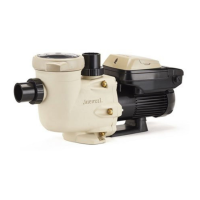Page 7 of 32 IS3206VSP3J Rev-A
2. General Information
2.1. Introduction
This manual contains information for the proper installation and operation of the 1.85 or 2.7THP variable speed pumps.
The instructions in this manual MUST be followed precisely.
2.2. Product Dimensions
3. Energy Efficiency Overview
The energy consumed by a pool pump is measured in terms of Watts (W) or Kilowatts (kW). The JVS185 and JVS270S variable
speed pumps display power consumption in Watts. Given this information, you can determine the cost of operating the pump:
Power consumption of pump X Cost of electricity = Cost of Pump Operation per Hour
Example: Variable speed pump operating at 300 W. Cost of electricity = $0.10 per kWh
Convert Watts to Kilowatts: 300 W = 0.3 kW
0.3 kW X $0.10/kWh = $0.03 per hour
Note the power consumption is greatly affected by the speed of the pump. Lowering the speed of the pump can drastically
reduce the power that is consumed. Below are some of the major benefits of running the pump at lower speeds.
Benefits of running at low speeds
Save electricity and money
Improved filtration – the filter can often remove smaller particles when the water moves slower
Quiet operation
Reduced Total Dynamic Head – less stress on equipment (e.g. filter) which can lengthen equipment life
When determining the speed(s) to operate your pump, you must also take into account the minimum
requirements for proper sanitation and equipment/water feature functionality.
It is recommended you filter (“turnover”) all the water in the pool at least once every 24 hours. Check with local requirements
for the minimum turnover rate. Running the pump at a lower speed may require running the pump for a longer period of time
in order to meet the turnover requirements for proper sanitation.

